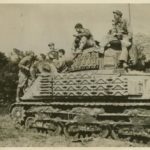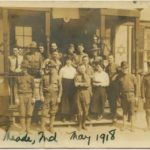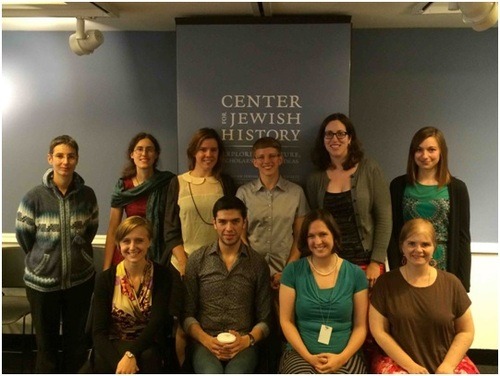In Honor of Veterans Day 2012
by David P. Rosenberg, M.P.A., Senior Reference Librarian – Collections, Center for Jewish History
The need to document those in our communities is a longstanding tradition in Judaism. Beginning in Biblical times there was the half-shekel annual accounting of all Jews where “the rich shall not pay more and the poor shall not pay less” (Exodus 30:15).
In the recent Center Symposium “History of Jewish Giving: Jews and Charity” Elisheva Baumgarten (Bar Ilan University-CAJS, University of Pennsylvania) discussed Memorbuch, tribute lists common with Central European Jews. The Leo Baeck institute has Memorbuchs that have been digitized and are available online—for example, the Memorbuch of the Jewish Community of Bretten.
Yizkor books are another example. “The YIVO Library holds more than 750 Yizker-bikher, or Memorial books to the hundreds of Jewish communities annihilated during the Holocaust by the Nazis and their collaborators, the largest collection in the United States. The word Yizkor in Hebrew and its Yiddish form, Yizker (literally: Remember) is the first word of a memorial prayer for the dead. These Memorial books were compiled by ad hoc committees of survivors, as a way to commemorate their families and friends who perished in the Holocaust.” (Source.) We also provide access to digitized Yizkor books, including those digitized by the New York Public Library.
One archival resource that is helpful for genealogists and scholars alike is the National Jewish Welfare Board, Bureau of War Records, held by the American Jewish Historical Society. (Call number I-52; finding aid here.) These records contain about 320,000 index cards and 85,000 individual service files for service members who fought in WWII. The National Jewish Welfare Board was founded in 1917 to provide support for soldiers in times of war. It was also a founding member of the United Service Organizations (USO).
In addition to these records there are detailed chaplains’ records: the National Jewish Welfare Board military chaplaincy records, I-249; finding aid here. (See also these posts on the American Military Chaplain experience.)
The finding aid for the National Jewish Welfare Board – Bureau of War Records collection details the interesting contents.
Many people start with 320,000 index cards: Series VI: Card files – Bureau of War Records, master index cards, 1943-1947: “The BWR transcribed information on the master card forms using several encoding schema. In one encoding scheme, labeled the Master Card Symbols, the BWR cut the left corner of a card to indicate that a soldier is one of several members of the same family who died during the war; punched a hole in the card to indicated that a soldier is not Jewish; stamped the word “authenticated” in a box if the information is verified; stamped XX if the case is in abeyance; or left the box blank if the case is pending (see Box 273, card 1).”
There are also two other series of particular interest to me. Series IV: Individuals: Record files for casualties and awards, 1942-1947. These records that memorialize the service of 85,000 individuals consist of, in part, “individual files on Jewish men and women who earned awards, suffered casualties, or were party to newsworthy events in the war. Information about Jewish service personnel is presented on standardized forms printed by the Bureau of War Records.” (Finding aid.)
Series V: Special studies, 1943-1946 is also fascinating; it includes information on families with multiple sons in the service and commissioned officers and refugees serving in the armed forces.
These records were further examined and compiled into a book: American Jews in World War II: the story of 550,000 fighters for freedom by Isidor Kaufman in 1947. This work only includes individuals if they ware “definitely known to be Jewish, as a result of careful authentication by the Bureau of War Records of the National Jewish Welfare Board and local war records committees.”
One member of the armed services I became familiar with through these records is Lieutenant Ruchamkin. “On 13 November 1942, Lieutenant (junior grade) Ruchamkin was killed during action against Japanese forces off Savo Island, Solomon Islands. He was posthumously awarded the Navy Cross for “ … extraordinary heroism as first lieutenant aboard the USS Cushing … While under vigorous bombardment by hostile naval units … Ruchamkin … efficiently directed the fighting of fires and the efforts to control damage. Leading his party to an area below decks to extinguish flames which were raging there, he never returned.” (Source.) He had a ship named after him, the USS Ruchamkin, it was eventually turned over to Columbia where she was commissioned as the Cordoba. The remaining structure is now being incorporated into a military museum, well inland, in Bogota, Columbia.
Veterans Day is also Armistice Day, the day World War I ended 94 years ago. Therefore, it is also appropriate to mention a few books held by the Leo Baeck Institute Library, including The German-Jewish soldiers of the First World War in history and memory by Tim Grady.
The reference collection of the Lillian Goldman Reading Room contains two important Gedenkbuchs that list Jewish Soldiers who fought for Germany in World War I. One is illustrated with photos of soldiers. It was published by a local branch of the Reichsbundes Juedischer Frontsoldaten.
There is also a more comprehensive Reichsbundes Juedischer Frontsoldaten publication published in 1932, the year before Hitler became Chancellor of Germany in the reference collection. It lists the 85,000 German Jewish Soldiers who fought and the 12,000 who died for Germany during the Great War. It was part of the efforts of the Reichsbundes Juedischer Frontsoldaten to prove that Jews were not disloyal to the countries they lived in.
———-
First photo above: 1945. Visit to front….. Chaplain Morris M. Berman, recently awarded the Bronze Star Medal, extreme left, chats with the crew of a Marine tank near the front lines on Okinawa. His citation reads in part, “For meritorious achievement in connection with operations against the Japanese enemy while serving as Assistant Division Chaplain, with special reference to the needs of Jewish men, on Okinawa Shima, Ryukyu Islands, from 1 April 1945 to 21 June 1945. Under the most hazardous conditions of combat, Chaplain Berman kept personal contact with the men in all regiments and battalions of the Division as well as in a number of attached organizations. On numerous occasions he exposed himself to sniper and shell fire in order to reach and minister to his men, and was tireless in his efforts to comfort and cheer the wounded…..” An alumnus of Yale University, the Jewish Institute of Religion, and Columbia University, Chaplain Berman entered the Navy Chaplaincy in May 1943. His wife and son live at 5048 South Woodlawn Avenue, Chicago, Illinois. c/o American Jewish Historical Society.
Second photo above: May 1918. Fort George G. Meade (Md.) National Jewish Welfare Board Records collection. c/o American Jewish Historical Society.




